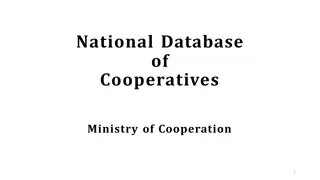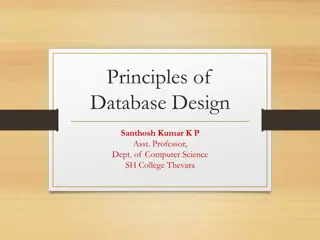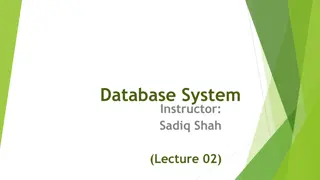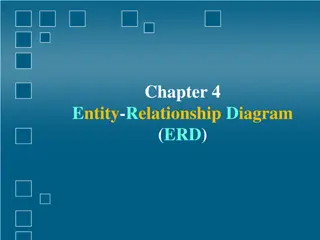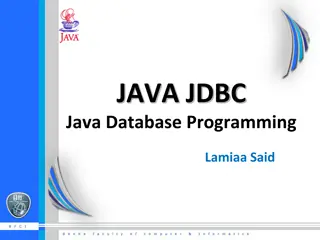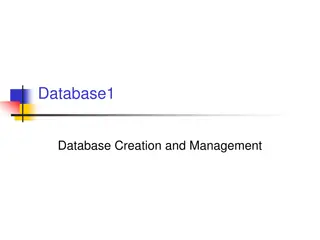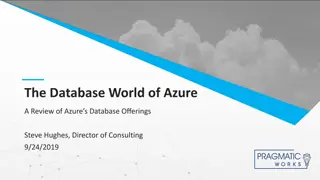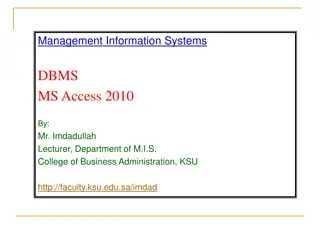Database Design Fundamentals
Database design is an essential aspect of building information systems. It involves creating a structure for storing and accessing data efficiently. Professionals use various techniques to design databases effectively. Understanding the basic concepts of databases is crucial before starting the design process. Explore the art of designing databases similar to constructing a house, ensuring a solid foundation for efficient data management. Dive into the realm of database management encompassing software, hardware, and organizational strategies.
Download Presentation

Please find below an Image/Link to download the presentation.
The content on the website is provided AS IS for your information and personal use only. It may not be sold, licensed, or shared on other websites without obtaining consent from the author.If you encounter any issues during the download, it is possible that the publisher has removed the file from their server.
You are allowed to download the files provided on this website for personal or commercial use, subject to the condition that they are used lawfully. All files are the property of their respective owners.
The content on the website is provided AS IS for your information and personal use only. It may not be sold, licensed, or shared on other websites without obtaining consent from the author.
E N D
Presentation Transcript
Course Code: CSC 422
Course Title: Database
Course Developer/Writer: A.T. Akinwale Dr.
& Miss A. J. Ikuomola Department of Computer Science College of Natural Science University of Agriculture Abeokuta, Ogun State, Nigeria
UNIVERSITY OF AGRICULTURE, ABEOKUTA
Designing a database is an art process similar to building a house. There are many techniques professionals via design databases. Before proceeding forward on database, there is a need to know the basic concepts of database.
concepts or instruction in a formalized manner suitable for communication, interpretation or processing by human or automatic means.
A database can be defined as central pool of data which is shared by various user of an organization.
system in a computer. A database system consists of the data structure, the suite of programs and the base used to put an information system on a computer.
Database management: comprises prises of software, hardware and organizational techniques to manage a database.
Data processing: is the execution of systematic sequence of operations performed upon data.
By Daniel Martin- He defines database as a collection of data that obeys three criteria:
Exhaustively means that all the data about the subject are actually present in the database.
Non_redundancy means that each individual piece of data exit only once in the database.
Appropriate structure means that the data are stored in such a way as to minimized the cost of the expected processing and storage.
For easy change in data linkage (for example, link a customer record to all transactions performed on his account: invoices, payments e.t.c)
Data base allow consolidating data entries among files.
Database allows fewer programs and simpler execution procedures
Database occupies all the consequences of an incoming transaction at one time.
Database reduces the rate of data redundancy.
Proposal for the development of Network model
Another group from IBM Research Laboratories at San Jose under the supervision of E.F Codd published a report in 1970, called CODD 70.
DBMS was in a state of abject turmoil (miserable disorder). There were arguments and counter-arguments. What CODA 71 claimed as advantages, the CODD 70 group claimed as disadvantages. The basic tenets of each proposal were questioned, examined and re-examined over and over again. Finally, one major fact stood out , that was,
Network model was shown to be reasonably efficiently implementable because it could handle large size of data base for over billion of bytes.
Relational model could only support relatively small database.
The future shape of DBMS had been decided.
The enterprise manager function performed by the enterprise manager
The database administrator function performed by database administrator.
The application administrator function performed by application administrator.
Has illusion that the logical structure of the data available to him or her is conformity with the demand.



